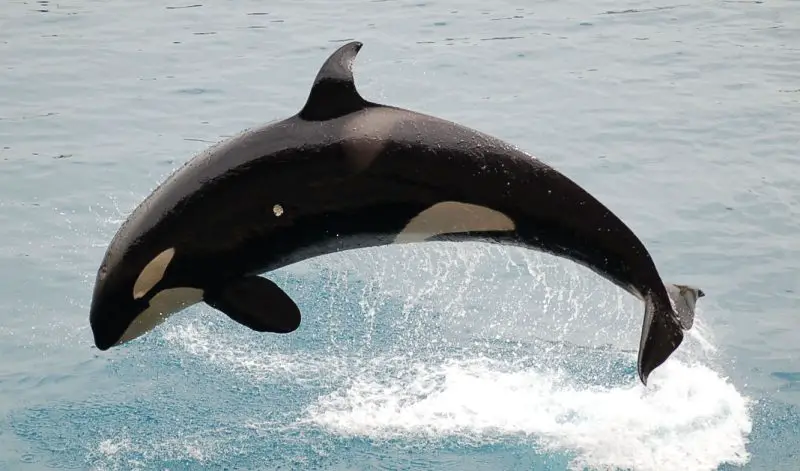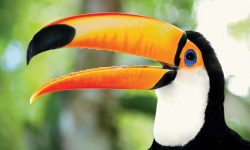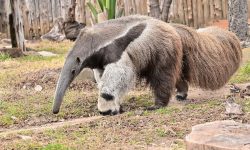When we think of dangerous animals in the ocean, images of sharks, jellyfish, or venomous fish often come to mind. But lurking beneath the waves is a marine predator so intelligent, strategic, and powerful that it outclasses even the great white shark. This is not a fish. It is a sea mammal—one with lungs, warm blood, and social structures rivaling those of primates. Its name?
The killer whale, or orca (Orcinus orca), holds the title as Earth’s most dangerous sea mammal. Despite its polished black-and-white appearance and appearances in marine parks, the orca is a highly evolved apex predator—one that has no natural enemies, preys on large marine animals, and hunts with chilling precision. In this article, we’ll explore what makes orcas so deadly, both biologically and behaviorally.

What Is a Killer Whale?
Not a Whale, but a Supersized Dolphin with a Killer Instinct
Despite their fearsome name, killer whales aren’t whales at all—at least not in the scientific sense. They belong to the Delphinidae family, which means that orcas are actually giant oceanic dolphins, closely related to species like the bottlenose dolphin. But unlike their playful cousins, orcas are built for power and precision. They are the largest dolphins on Earth, and arguably the most intelligent marine predators alive.
An adult male orca can stretch more than 30 feet (9 meters) in length—about the size of a school bus—and tip the scales at over 6 tons. One of their most striking features is the towering dorsal fin, which can rise over 6 feet high in males, slicing through the water like a sail. Their black-and-white coloring isn’t just iconic—it’s camouflage. Seen from below, their white bellies blend with the bright surface; from above, their black backs merge into the ocean depths.
But their physical appearance is only part of what sets them apart. Orcas are remarkably adaptable, found in every ocean on the planet. From the ice-choked seas of the Arctic to the warm, coral-fringed waters of the tropics, orcas thrive in environments as varied as their diets. Some specialize in hunting seals among floating ice. Others target tuna or even blue whales in the open ocean.
What truly defines an orca, however, isn’t just size or range—it’s intelligence, social complexity, and raw predatory skill. Each population, or ecotype, has its own language, culture, and hunting methods passed down through generations. In short, a killer whale is not simply a massive dolphin—it’s a strategic, thinking hunter, sculpted by evolution into a near-perfect ocean predator.
Why Orcas Are the Ocean’s Apex Predator
No Natural Enemies, No Equals
In the food web of the ocean, orcas reign with undisputed dominance. There is no creature—shark, whale, or otherwise—that hunts the killer whale. Even the legendary great white shark, so often painted as the sea’s deadliest threat, becomes prey in the presence of orcas. In multiple documented encounters, orcas have killed great whites with eerie precision, extracting only their fat-rich livers and leaving the rest untouched. It’s not just strength that gives orcas their power—it’s surgical intelligence.
A Menu Like No Other
Orcas boast the most diverse diet of any marine mammal, a feat made possible by their global distribution and adaptable culture. They are opportunistic but strategic, feasting on:
-
Seals basking on ice
-
Sea lions patrolling rocky shores
-
Penguins in Antarctic waters
-
Dolphins and other whales, including blue whale calves
-
Large fish like salmon, herring, and even massive tuna
-
Squid in deep offshore zones
-
Sharks, from reef species to makos
But here’s the astonishing part—not all orcas eat the same thing. Each pod, or ecotype, has evolved its own unique hunting techniques and dietary preferences, passed down like culinary traditions in human cultures. In Antarctica, one pod may ambush penguins, while another hunts minke whales. Along Argentina’s coast, some individuals intentionally beach themselves to seize young seals from the shore—a high-risk, high-reward tactic that few predators on Earth would dare.
Hunting with the Precision of Special Forces
Orcas aren’t just hunters—they’re tactical predators. They operate in highly organized matrilineal pods, led by experienced females who may live over 80 years. Within these tight-knit families, orcas communicate using distinctive vocal dialects, coordinate complex maneuvers, and adapt strategies in real time.
Some of their most jaw-dropping hunting techniques include:
-
Carousel feeding – Herding schools of herring into dense “bait balls,” then stunning them with tail slaps before calmly plucking them from the water one by one
-
Wave washing – Swimming in formation to generate waves powerful enough to knock seals off ice floes
-
Echolocation pinning – Using sonar clicks to isolate prey in murky or deep water, targeting them with unerring accuracy
-
Shark flipping – Flipping sharks upside down to induce tonic immobility, rendering them temporarily paralyzed
These behaviors are not merely instinct—they are learned, practiced, and refined across generations. In this sense, orcas represent not just apex predators, but culturally complex hunters—creatures that blend strength, skill, and social learning in a way that has no parallel in the sea.
Are Orcas Dangerous to Humans?
In the Wild: Majestic, Curious, and Cautious
Given their size, power, and predatory skill, one might expect orcas to be a serious threat to humans in the wild. But in reality, wild orcas are remarkably restrained. There are only a handful of recorded incidents involving aggressive behavior, and no documented cases of a wild orca killing a human. Most encounters are defined by curiosity rather than confrontation—orcas following boats, peeking at divers, or mimicking sounds from snorkelers.
Still, this is a predator that can weigh six tons and move with startling speed. An orca doesn’t have to mean harm to cause harm. Accidental collisions or sudden shifts in behavior—especially if humans approach too closely or unknowingly disrupt a pod—can have serious consequences.
Wild orcas deserve not fear, but respect and distance.
In Captivity: Beauty Turned Tragic
The orca’s behavior changes dramatically in captivity—and not for the better. In the confined, artificial world of marine parks, where social bonds are fractured and mental stimulation is scarce, orcas have shown a darker, more volatile side.
Nowhere is this more tragically illustrated than in the case of Tilikum, the massive male orca involved in three human deaths, including that of SeaWorld trainer Dawn Brancheau in 2010. Tilikum spent most of his life in isolation or under stress, a reality mirrored in the erratic and sometimes violent behavior seen in other captive orcas worldwide.
While wild orcas display tight social structures, rich communication, and learned cultural behaviors, captive orcas are often stripped of these elements—trapped in sterile pools and cut off from the environment their minds and bodies evolved to thrive in. The result? A powerful animal reduced to frustration and confusion.
These incidents serve as haunting reminders: an apex predator cannot be tamed by concrete walls and choreographed routines. The orca’s danger lies not in its nature, but in the unnatural conditions we sometimes impose upon it.
Other Deadly Sea Mammals Worth Mentioning
While the orca dominates the top of the oceanic food chain, it’s not the only sea mammal capable of delivering lethal power. Scattered across the world’s oceans are a handful of others—less famous perhaps, but no less formidable in their own right.
The Leopard Seal: Antarctica’s Ambush Artist
Sleek, muscular, and cold-bloodedly efficient, the leopard seal (Hydrurga leptonyx) is the top non-orca predator in Antarctic waters. With a snake-like body and a reptilian grin filled with serrated teeth, this pinniped patrols the ice edge in search of penguins—its favorite meal. It has even been known to attack other seals and scavenge carcasses, displaying a level of opportunism rare among marine mammals.
While rarely hostile toward humans, leopard seals have shown aggressive curiosity, sometimes biting inflatable boats or approaching divers underwater. In their icy realm, they rule with stealth and muscle, and their ambushes beneath the ice are sudden, swift, and rarely survived.
The Walrus: Arctic Titan with Tusks
At first glance, the walrus (Odobenus rosmarus) may seem slow-moving and benign, lounging on ice floes in massive herds. But with tusks that can reach over three feet long and a body mass of up to 4,000 pounds, the walrus is no pushover. When threatened—especially when protecting calves—walruses can become extremely aggressive, capable of capsizing small boats and goring predators or intruders.
Though encounters with humans are rare, Arctic researchers and Indigenous hunters know to approach walruses with caution. They may not hunt other animals, but when provoked, they fight with explosive force.
The Sperm Whale: Deep-Sea Giant with a Legendary Past
As the largest toothed predator on Earth, the sperm whale (Physeter macrocephalus) commands awe with sheer scale. These leviathans can dive over 3,000 feet in pursuit of their prey—giant squid—engaging in battles that leave both combatants scarred. With a head full of echolocating sonar and a jaw lined with teeth the size of bananas, the sperm whale is a living submarine built for the abyss.
Although not aggressive by nature, sperm whales once had a fearsome reputation. In the age of wooden ships, desperate whalers learned just how dangerous a cornered sperm whale could be. Some were known to ram vessels, and at least one historic incident—the sinking of the whaleship Essex in 1820—inspired Moby-Dick.
None Rival the Orca
Each of these sea mammals is impressive in its own right—stealthy, strong, or simply colossal. But none possess the orca’s full suite of apex traits: wide-ranging diet, unmatched hunting intelligence, cooperative strategies, and social complexity. While others excel in strength or ferocity, only the orca blends power with precision, brute force with brainpower, making it Earth’s undisputed most dangerous sea mammal.
Why Orcas Deserve Our Caution and Respect
Orcas are not just dangerous—they are smart, emotional, and socially complex animals. They form life-long family bonds, mourn their dead, and even display behaviors that resemble play and empathy. Their danger does not come from malice, but from their evolutionary perfection as predators.
They also face many threats: pollution, declining fish stocks, noise disturbance, and captivity. Understanding their danger should not make us fear them—but rather, inspire us to protect their natural habitats and let them thrive in the wild.
Conclusion
The killer whale, or orca, stands unrivaled as Earth’s most dangerous sea mammal—not because it seeks violence, but because it embodies everything that makes a predator great: strength, speed, intelligence, and social unity.
As we continue to explore and share the ocean with these incredible creatures, one truth becomes clear: the most fearsome marine hunter doesn’t have gills or rows of razor teeth—it breathes air, raises families, and outsmarts its prey in chillingly coordinated silence.






